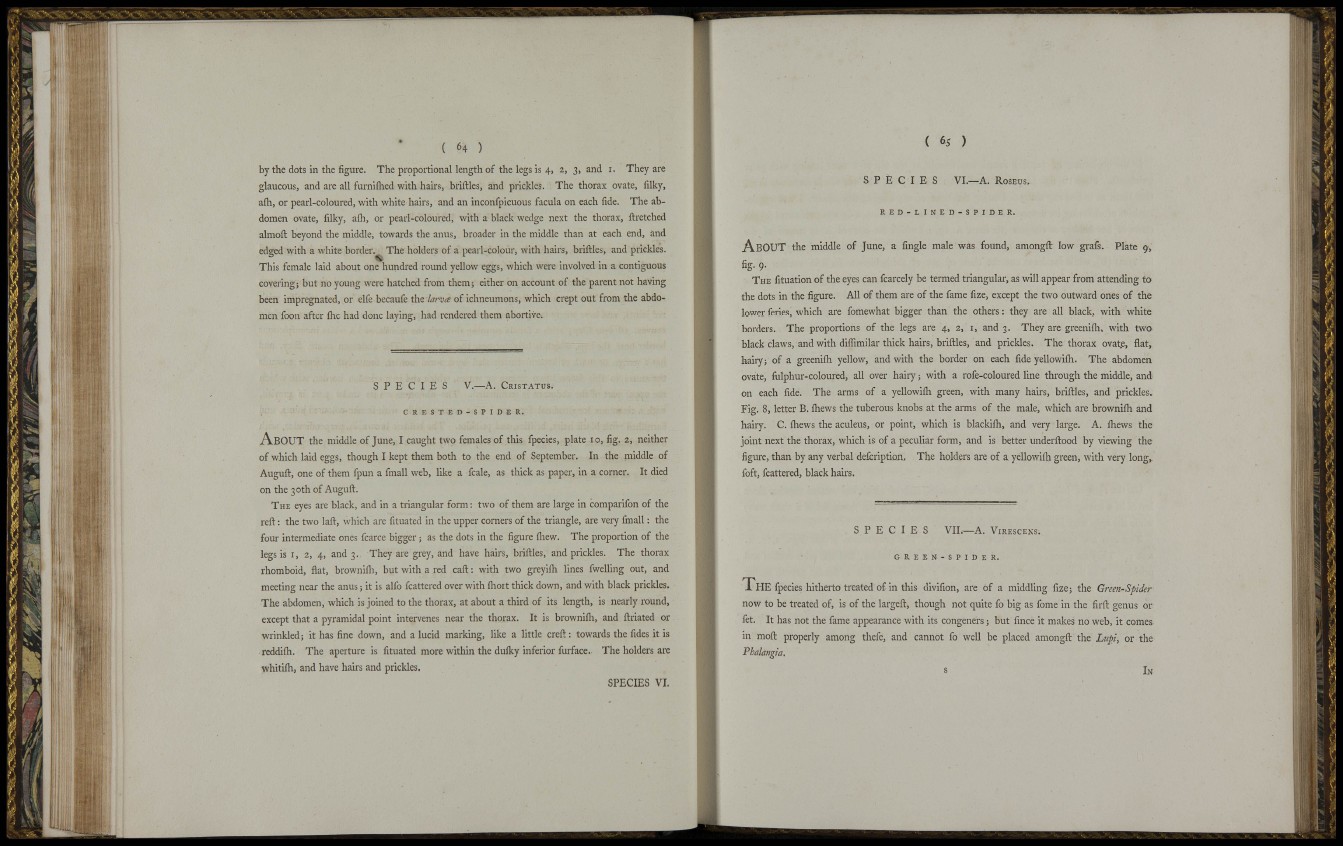
( 64 )
by the dots in the figure. The proportional length of the legs is 4, 2, 3, and i. They are
glaucous, and are all furniflied with hairs, briftles, and prickles. The thorax ovate, filky,
aih, or pearl-coloured, with white hairs, and an inconfpicuous facula on each fide. The abdomen
ovate, filky, afli, or pearl-coloured, with a black wedge next the thorax, ñretched
almoft beyond the middle, towards the anus, broader in the middle than at each end, and
edged with a white border. The holders of a pearl-colour, with hairs, briftles, and prickles.
This female laid about one hundred round yellow eggs, which were involved in a contiguous
covering; but no young were hatched from them; either on account of the parent not having
been impregnated, or elfe becaufe the larva of ichneumons, which crept out from the abdomen
foon after ihe had done laying, had rendered them abortive.
S P E C I E S v.—A. CRISTATUS.
C R E S T E D - S P I D E R .
A B O U T the middle of June, I caught two females of this fpecies, plate 10, fig. 2, neither
of which laid eggs, though I kept them botli to the end of September. In the middle of
Auguft, one of them fpun a fmall web, like a fcale, as thick as paper, in a corner. It died
on the 30th of Auguft.
THE eyes are black, and in a triangular form: two of them are large in comparifon of the
reft: the two laft, which are fituated in the upper corners of the triangle, are very fmall: the
four intermediate ones fcarce bigger; as the dots in the figure ihew. The proportion of the
legs is I, 2, 4, and 3. They are grey, and have hairs, briftles, and prickles. The thorax
rhomboid, flat, brownifli, but with a red caft: with two greyifli lines fwelling out, and
meeting near the anus; it is alfo fcattered over with flioit thick down, and with black prickles.
The abdomen, which is joined to the thorax, at about a third of its length, is nearly round,
except that a pyramidal point intervenes near the thorax. It is brownifta, and ftriated or
wrinkled; it has fine down, and a lucid marking, like a little creft: towards the fides it is
reddifti. The aperture is fituated more within the duflcy inferior furface. The holders are
whitiih, and have hairs and prickles.
SPECIES VI.
( 65 )
S P E C I E S VI.—A. ROSEUS.
R E D - L I N E D - S P I D E R .
A B O U T the middle of June, a fingle male was found, amongft low grafs. Plate g,
fig. 9.
THE fituation of the eyes can fcarcely be termed triangular, as will appear from attending to
the dots in the figure. All of them are of the fame fize, except the two outward ones of the
lower feries, which are fomewhat bigger than the others: they are all black, with white
borders. The proportions of the legs are 4, 2, i, and 3. They are greeniili, with two
black claws, and with diffimilar thick hairs, briftles, and prickles. The thorax ovate, flat,
hairy; of a greenifli yellow, and with the border on each fide yellowifti. The abdomen
ovate, fulphur-coloured, all over hairy; with a rofe-coloured line through the middle, and
on each fide. The arms of a yellowifli green, with many hairs, briftles, and prickles.
Fig. 8, letter B. ihews the tuberous knobs at the arms of the male, which are brownifti and
hairy. C. fliews the aculeus, or point, which is blackifh, and very large. A. fhews the
joint next the thorax, which is of a peculiar foi-m, and is better underftood by viewing the
figure, than by any verbal defcription. The holders are of a yellowiih green, with very long,,
foft, fcattered, black hairs.
S P E C I E S VIL—A. ViREscENs.
G R E E N - S P I D E R .
T H E fpecies hitherto treated of in this diviiion, are of a middling fize; the Green-Spider
now to be treated of, is of the largeft, though not quite fo big as fome in the firft genus or
fet. It has not the fame appearance with its congeners; but fince it makes no web, it comes
in moft properly among thefe, and cannot fo well be placed amongft the Lupi, or the
Phalangia.
s IN
1
V I |